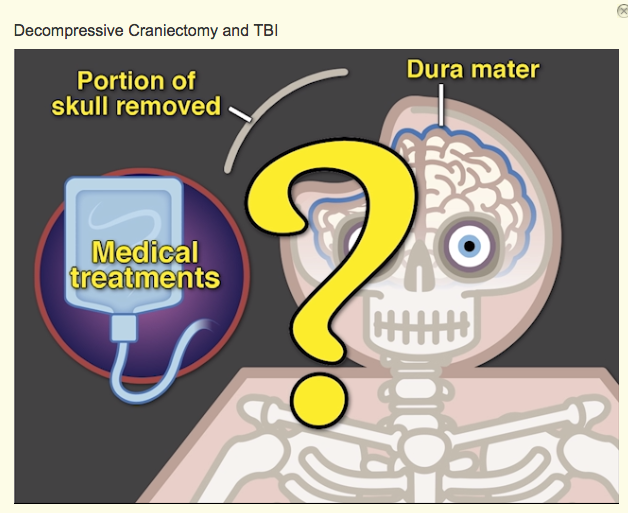Trial of Decompressive Craniectomy for Traumatic Intracranial Hypertension
Peter J. Hutchinson, Ph.D., F.R.C.S. (SN), Angelos G. Kolias, Ph.D., M.R.C.S., Ivan S. Timofeev, Ph.D., F.R.C.S. (SN), Elizabeth A. Corteen, M.Sc., Marek Czosnyka, Ph.D., Jake Timothy, M.D., F.R.C.S. (SN), Ian Anderson, F.R.C.S. (SN), Diederik O. Bulters, B.Sc., F.R.C.S. (SN), Antonio Belli, M.D., F.R.C.S. (SN), C. Andrew Eynon, M.D., F.R.C.P., John Wadley, F.R.C.S. (SN), A. David Mendelow, Ph.D., F.R.C.S. (SN), Patrick M. Mitchell, Ph.D., F.R.C.S. (SN), Mark H. Wilson, Ph.D., F.R.C.S. (SN), Giles Critchley, M.D., F.R.C.S. (SN), Juan Sahuquillo, M.D., Ph.D., Andreas Unterberg, M.D., Ph.D., Franco Servadei, M.D., Graham M. Teasdale, F.Med.Sci., John D. Pickard, F.Med.Sci., David K. Menon, F.Med.Sci., Gordon D. Murray, Ph.D., and Peter J. Kirkpatrick, F.Med.Sci., for the RESCUEicp Trial Collaborators*
September 7, 2016DOI: 10.1056/NEJMoa1605215
![]() Comments open through September 14, 2016
Comments open through September 14, 2016
-
BACKGROUND
The effect of decompressive craniectomy on clinical outcomes in patients with refractory traumatic intracranial hypertension remains unclear.
METHODS
From 2004 through 2014, we randomly assigned 408 patients, 10 to 65 years of age, with traumatic brain injury and refractory elevated intracranial pressure (>25 mm Hg) to undergo decompressive craniectomy or receive ongoing medical care. The primary outcome was the rating on the Extended Glasgow Outcome Scale (GOS-E) (an 8-point scale, ranging from death to “upper good recovery” [no injury-related problems]) at 6 months. The primary-outcome measure was analyzed with an ordinal method based on the proportional-odds model. If the model was rejected, that would indicate a significant difference in the GOS-E distribution, and results would be reported descriptively.
RESULTS
The GOS-E distribution differed between the two groups (P<0.001). The proportional-odds assumption was rejected, and therefore results are reported descriptively. At 6 months, the GOS-E distributions were as follows: death, 26.9% among 201 patients in the surgical group versus 48.9% among 188 patients in the medical group; vegetative state, 8.5% versus 2.1%; lower severe disability (dependent on others for care), 21.9% versus 14.4%; upper severe disability (independent at home), 15.4% versus 8.0%; moderate disability, 23.4% versus 19.7%; and good recovery, 4.0% versus 6.9%. At 12 months, the GOS-E distributions were as follows: death, 30.4% among 194 surgical patients versus 52.0% among 179 medical patients; vegetative state, 6.2% versus 1.7%; lower severe disability, 18.0% versus 14.0%; upper severe disability, 13.4% versus 3.9%; moderate disability, 22.2% versus 20.1%; and good recovery, 9.8% versus 8.4%. Surgical patients had fewer hours than medical patients with intracranial pressure above 25 mm Hg after randomization (median, 5.0 vs. 17.0 hours; P<0.001) but had a higher rate of adverse events (16.3% vs. 9.2%, P=0.03).
CONCLUSIONS
At 6 months, decompressive craniectomy in patients with traumatic brain injury and refractory intracranial hypertension resulted in lower mortality and higher rates of vegetative state, lower severe disability, and upper severe disability than medical care. The rates of moderate disability and good recovery were similar in the two groups. (Funded by the Medical Research Council and others; RESCUEicp Current Controlled Trials number, ISRCTN66202560.)
READ MORE: http://www.nejm.org/doi/full/10.1056/NEJMoa1605215

